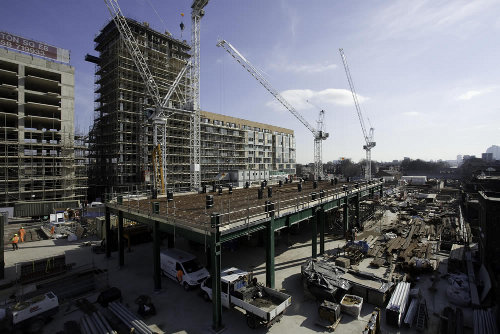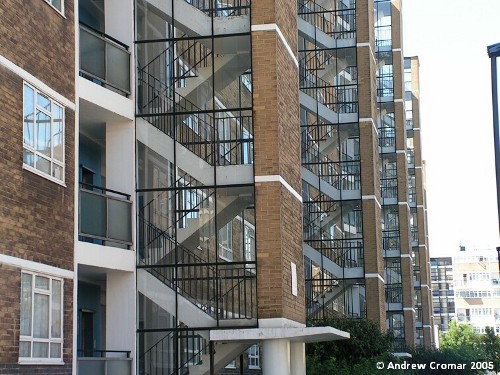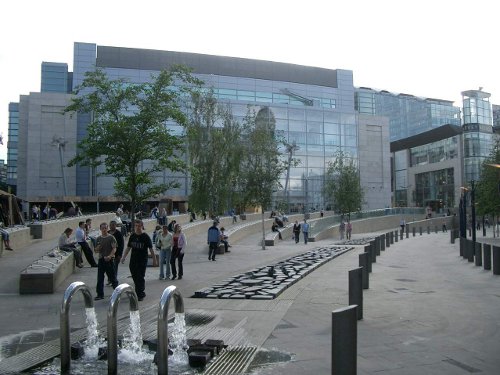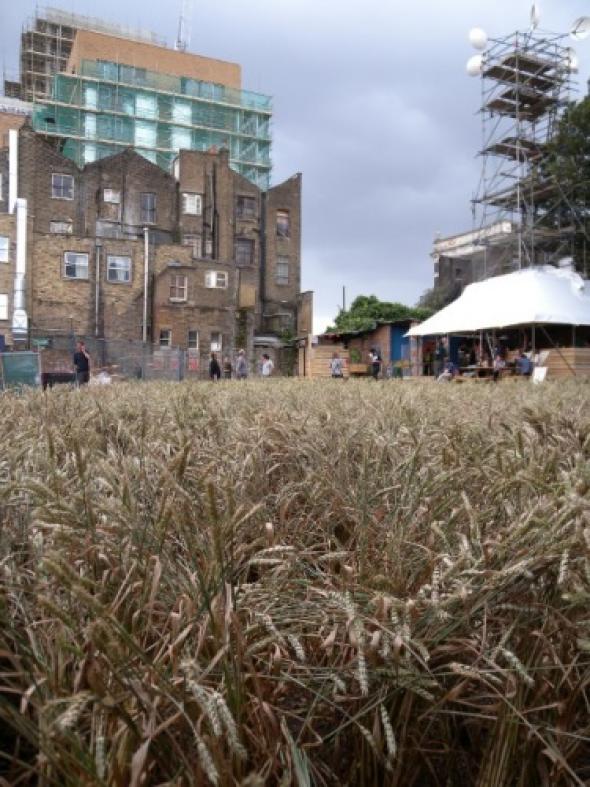Hung, Drawn and 'Quartered'?
Two recently published books – Anna Minton’s Ground Control and This is Not a Gateway’s Critical Cities – take stock of the accumulated effects of New Labour’s ‘urban renaissance’. In his double review, Owen Hatherley sees the tired politics of micro-resistance go head-to-head with some much needed materialist geography
Irrespective of its courting of suburbia, New Labour was very much an urban party. Its bases remained in ex-industrial cities, and its hierarchy was drawn from North London, Greater Manchester and Edinburgh. The Tories, despite their capture of the Greater London Authority, are essentially an outer-suburban and rural party, so it will be instructive to find out what they plan to do with one of the major Blairite shibboleths – the ‘urban renaissance’. Coined in the late 1990s by either Ricky Burdett, Anne Power or Richard Rogers, under the auspices of John Prescott and the Urban Task Force, this has become the emblematic term of a middle class return to the cities, and an attendant redevelopment of previously demonised urban spaces. Often this is associated with a particular kind of urban paraphernalia. In terms of architectural artefacts, the urban renaissance has meant lottery funded ‘centres’, entertainment venues and shopping/eating complexes, clustered around disused river-fronts (Salford Quays, Cardiff Bay, the Tyneside ensemble of Baltic, Sage and Millennium Bridge); in housing, ‘mixed use’ blocks of flats on brownfield sites, the privatisation of council estates, the reuse of old mills or factories; extensive public art, whether cheerful or enigmatically Gormleyesque, usually symbolising an area’s phoenix-like re-emergence; districts become branded ‘quarters’; and, perhaps most curiously, piazzas (or, in the incongruously grandiose planning parlance, ‘public realm’) appear, with attendant coffee concessions, promising to bring European sophistication to Derby or Portsmouth.
The process is partial and unevenly scattered, but reaches its most spectacular stretch in the miles of luxury flats in the former London Docks, the new high-rise skyline of Leeds, the privatised retail district of Liverpool One, or the repopulation of central Manchester. Irrespective of the virtues or otherwise of these new spaces, this urban renaissance is widely considered to have ended in aforementioned city centre flats sitting empty, as if the exodus from the suburbs to the cities was a failed confidence trick. It has left behind half-finished, empty or cheaply-let towers in Glasgow, Stratford or Sheffield which stand both as symbols of the euphemistic ‘credit crunch’, or the failure, as suburban boosterism might have it, of an attempt to cajole people into a form of living alien to British predilections (although the linked subprime crash in the USA was a suburban rather than inner city phenomenon). The two books under review here attempt to offer some kind of reckoning with the urban renaissance. Anna Minton’s Ground Control – Fear and Happiness in the 21st Century City sets out to systematically describe a paranoid, privatised new landscape, while This Is Not A Gateway’s Critical Cities – Ideas, Knowledge and Agitation from Emerging Urbanists, edited by an academic and a ‘regeneration professional’, Deepa Naik and Trenton Oldfield, offers a rather more impressionistic approach. In both cases we appear to be dealing with former believers in the urban renaissance who have been gradually disappointed by the failures of Blairite urbanism. Gentrifiers against gentrification, we could say. Nonetheless, the difference between the relative force and sophistication of the critiques in these two books is wide indeed.
This is Not A Gateway describes itself as an ‘urban platform’, and this is their first anthology. Although they are at pains to stress how inclusive and interdisciplinary the platform is, with contributions showing an impressive range, from aesthetics to health, from art to gardening, the book is mostly derived from various ‘salons’ at Dalston’s Cafe Oto – so many contributions are reviews of or summaries from meetings to which the reader will not have been privy. This tension between an insider perspective and an ostentatious, outreaching friendliness runs throughout Critical Cities. There is also a tension among the contributors between those who are genuinely ‘critical’ of recent policy and those who have, frankly, created, administered and apologised for it from the off. This is obvious from two of the book’s several introductions. First, we have a preface from Jemma Basham of the Homes and Communities Agency, the quango that is the successor to the Housing Corporation and the part-privatisation sponsors English Partnerships. Basham works for the ‘HCA Academy’, about whom the byline optimistically notes that ‘its current priority is to give people tools and know-how to deal with the recession and prepare themselves for the upturn’. The HCA also recently bailed out property developers to the tune of £2.8 billion, and is headed by Sir Bob Kerslake, who demolished a prodigious amount of council housing in his time as (unelected) boss of Sheffield City Council and, as Critical Cities is ‘made possible with the support of the Homes and Communities Agency’, one should expect any critique of these policies to be muted or non-existent. Basham’s brief but reiterated point is cohesion, consensus, the importance of everyone coming together during the recession, a Keep Calm and Carry On rhetoric which will recur in other contributions. The next introduction is by none other than ‘Ricky’ Burdett, alleged coiner of the very term ‘urban renaissance’. ‘City-thinking for City-building’ is his subject here (the italics are Burdett’s). It’s a resolutely uncontroversial plea for interdisciplinarity and concrete intervention in the midst of the threats of climate change and the global (if not necessarily national) expansion of cities. Anything non-‘inclusive’ is lurking below the surface rather than explicitly stated – the insistence that ‘global cities’ remain ‘competitive’, or the praise of ‘leadership’ and ‘big-city mayors’ in Bogota and elsewhere.
What exactly is the critique offered in Critical Cities? The phraseology used by the editors differs, at times, rather radically from the affirmationism of the urban renaissance. Their very name, evoking that curiously suburban New Labour non-plan, the ‘Thames Gateway’, sounds like a critique of recent planning policy. Here we also find not only the lately deeply unfashionable notion of the ‘critical’, but the possibility of ‘agitation’, and the idea that urban issues are worth getting angry about. This is laudable enough, and Oldfield & Naik attempt to sum up the process of gentrification and enclosure with the phrase ‘erase, stretch, relinquish’. The example used will be familiar to many Mute readers – the Dalston Junction regeneration scheme, where first the existing Georgian and Victorian landscape was erased, the units in the replacement luxury flats were ‘stretched’, and, when sold off to buy-to-let landlords, the developers of the site will no doubt ‘relinquish’. This is a fair summation, and it cannot be pointed out often enough that schemes like Dalston Junction are emphatically not in the interest of the local ‘community’ (to use the Blairite term invoked as an uncritical good on almost every page in both of these books).
Still, there is occasionally something unsatisfying about a critique of this sort, something peculiarly retrograde: an English Heritage form of community activism. The solicitor Bill Parry-Davies’ contribution entails a critique of the Dalston Junction scheme and an explanation of the legal architecture underpinning such grand regeneration projects, along with advocacy on behalf of OPEN Dalston, the group which has attempted to stop the demolition of a venue, shops and housing in favour of two tower blocks (neither of which will include ‘affordable’ housing) as part of a Transport for London ‘hub’. It is useful and politically astute, yet the invocation of ‘heritage’ is hardly unambiguous. Tower blocks, such as those proposed for the Dalston site, are apparently an ‘alien typology’, which will be news to the many in Hackney who have lived in them for the last half-century. Consider the likely effect if Hackney Council were to acquiesce in the proposed renovation and cleaning of the area’s Georgian properties and the Four Aces nightclub – a heritage showpiece ten minutes from the Square Mile, which might just be more of a draw to the affluent than two towers of Barratt’s micro-flats. It has the potential to be a new Covent Garden or Portobello, ready for resettling and cleansing. A positive proposal that didn’t involve the patching up of substandard Georgiana was conspicuous by its absence. Re-used old space is as much, if not more of a feature of gentrification than new space, but this interests the contributors rather less. Everyone hates a tower block, after all.

Image: Building development at Dalston Junction, London
The contributors often seem to have a very particular idea about where the urban renaissance went wrong – through the repetition of the ‘mistakes of the 1960s’, in the form of modernist architecture and high-rise towers. Lea Ayoub’s ‘Public Air Space – Planning and Accessing Tall Buildings in London’ is a straightforward critique of the high-rise offices and flats that have made a tentative return to the capital over the last decade. She writes that ‘before this building boom, the main local experience and reference for tall buildings were those of the 1960s and 1970s, which have been mostly relegated to the periphery and generally convey an image of housing and planning failure and social exclusion’, and approvingly quotes Jane Jacobs on modernism as the ‘rape of cities’. Now, irrespective of the accuracy or otherwise of this blanket moral judgement in which either something as successful as Pimlico’s Churchill Gardens or as cheap and nasty as Canning Town’s Freemasons Estate becomes part of the same failed experiment, there is a worthwhile point here. For developers, there is a certain historical obstacle to the neoliberal high-rise city in the form of the immediate revulsion brought on by the memory of sink estates and serried ranks of prole-containing towers, which the ‘iconic’ design of City skyscrapers (Gherkin, soon to be followed by ‘Walkie-Talkie’, ‘Shard’ et al) attempts to circumvent, transforming stacked trading floors into fodder for tourist snapshots.
This hostility to modernism and to planning also features in Alan Thompson’s two essays here on health in cities, where he outlines the modernist failings of Northwick Park NHS hospital (most notably, it was lamentably uninterested in ‘beauty’), and gives ’60s hospitals’ architecturally inept and wildly expensive exurban PFI replacements an inexplicably easy ride. Aside from its complicity with the demolition of postwar modernist estates, schools or NHS hospitals and their replacement with the Private Finance Initiative, City Academies and Public-Private ‘mixed communities’, what is really worrying in this reiterated argument is the fact that academics, planners, architects and urbanists are still clearly terrified by the idea of large-scale planning, of new space, of any kind of architecture which is not ‘in keeping’ with the heritage city, as if fearing they might find themselves demonised as ‘social engineers’, much as they were in the 1970s and ’80s. We do have critiques of the expensive and privatised nature of high-rise towers, and in the case of Louis Moreno’s essay here on the ‘architecture’ of the financial crisis, this can be politically cogent and insightful. Yet there’s no critique of the most notable urban artefact of the ‘urban renaissance’ in London – the four to eight storey blocks of yuppiedromes, built on brownfield site or former council estate, with shops (or Estate Agent) on the ground floor and ‘public realm’ as sops to the planning officers – an urban typology which is both extremely common and frequently privatised or gated, but whose low-rise nature and brick and/or render and/or wood cladding is presumably less offensive to heritage sensibilities. Either way, it is a shame that planners and architects seem so uninterested in offering some kind of alternative, speculative space to that of speculative capital.

Image: Philip Powell & Hidalgo Moya's Churchill Gardens Estate, Pimlico, London, 1947-62
What, then, of the promised ‘agitation’, or of positive proposals? OPEN Dalston is clearly one such example, holding out the possibility that an area can at least attempt to resist gentrification. Elsewhere the proposals range from small-scale improvements in the urban experience to some fairly empty-headed art practices. In the former category there is Heather Ring’s proposal for a ‘guerilla greenbelt’, bringing together the ad hoc plantings on the disused edges of urban space. It’s a proposal which will no doubt make the city look marginally nicer until the building contractors tear out the lobelia. But, pitched against the combined arsenal of the developers, the banks and their pliant councils, it seems more an act of mourning than of resistance, although at least Ring’s proposal to unify these scattered plantings has some totalising ambition. In the other category, we have Hilary Powell’s piece on the 2012 Olympics, a whimsically retardataire lament on the lack of good old British Blitz Spirit in the Olympics, its lamentable gigantism. Why, she asks, can’t it be just a bit nicer, a bit more like the ‘austerity Olympics’ of 1948, show more of ‘the DIY ethos of making do and getting by, keeping calm and carrying on’. The possibility of imagining large-scale interventions or communal spaces is still mostly bypassed in favour of preemptively ineffectual notions of micro-resistance. In Critical Cities this alternately entails picturesque images of Japanese tent cities, or, in one of several ‘curated interviews’ here, one contributor praising how Dubai’s indentured workers use the ultra-motorised city in an unplanned manner, carving out their own spaces. Regardless, a slave who ‘creatively’ ‘subverts’ space is still a slave.
While Critical Cities shows certain academics, planners, architects and artists inching towards some kind of break with urbanist orthodoxy, it’s still too tied into it to truly convince. This makes it all the more remarkable that Ground Control, written by a former Financial Times staffer as a distillation of a series of reports for think-tanks, is so ferocious, so precise and so instructive in its comprehensive critique of British neoliberal urban policy. However, when it comes to alternatives Minton falters too, albeit with rather less bathos than some of the authors in Critical Cities. The scope does not entail the latter’s trips to various Global Cities, there are no rhetorical excursions to Shenzen, Dubai or Tokyo, while Manchester and Liverpool get as much attention as East London. The specific focus on the British city makes it a case study in a particularly extreme variant of neoliberalism, which untangles the acronyms, catchphrase policies and quangos that administer its urban policy rather than adding another layer of jargon. Although Minton is no theorist and certainly no Marxist, this book is an excellent example of the kind of critical, materialist geography which could – and should – replace the tired focus on micro-subversions and micro-resistances.
Ground Control begins with an analysis of Canary Wharf, which Minton sees as the first draft of a new urbanism that has spread from there across Britain. She stresses that Blairite policy here is a peculiar outgrowth of both post-war dirigisme and Thatcherism, in the form of the ubiquitous Urban Development Corporations. Set up on the model of the New Town Development Corporations of the Attlee era, which had enormous and fundamentally unaccountable power over land, planning and building, areas of London, Tyneside and Liverpool essentially became exempt from democratic control in the 1980s, lest regeneration be compromised by ‘loony left’ Labour councils. Before selling up to developers, these instruments of state would create privately owned, privately patrolled enclaves at enormous public expense. These were expanded under New Labour into a dizzying amount of quangos and acronyms, but the major case study in the book is Manchester – and not the least of Ground Control’s grim pleasures is Minton’s striking redress to the Mancunian boosterism of the last two decades. Rather than taking control of a small area, she notes that the entire centre of Manchester is run as a ‘Business Improvement District’, specifically by the private company Cityco, creating what she calls a ‘pseudo-private space – streets and open spaces which are publicly owned but are actually privately controlled’. Minton argues persuasively that the reasoning behind this is linked closely with Blairism’s ‘respect agenda’ (particularly in the form of the Anti-Social Behaviour Order), to a concern with security and public order, the fear of the mob. So in the case of Greater Manchester there is a situation where, in Salford, more is spent on the issuing of ASBOs than on youth services, and where the ‘transformed’ centre and docks barricade themselves against an outskirts of criminalised poverty.
Another of Ground Control’s great strengths is its stress on the interdependence of government and business, with massive state programmes aimed essentially at creating a more lucrative market. The most impressive of these, which she profiles in alarming detail, is the ‘Pathfinder’ Housing Market Renewal Scheme. In essence, this was an attempt to create in northern post-industrial cities a housing boom to balance London’s, through the demolition of huge swathes of terraces, council houses and flats, using the same apparatus of compulsory purchase and clearance that was used in the post-war decades, although this time employed to very different ends – to increase demand for housing, rather than to rehouse the population in more sanitary, if perhaps less picturesque circumstances. She quotes one Liverpudlian campaigner: ‘with the destruction of the sixties, at least they had the excuse that they were building the New Jerusalem. Now it’s all about land deals’. The book makes clear that there was and is extensive opposition to Pathfinder, but that legal victories or upheld complaints came up against a rigged system – while ‘the independent evaluation of the programme commissioned by the government was undertaken by Nevin Leather Associates, a consultancy co-founded by Brendan Nevin – the architect of Pathfinder himself.’ One of the many upshots of this alliance between state and capital is a lucrative market for unregulated private landlords.

Image: Exchange Square in Manchester
In theoretical terms, Ground Control sets up an opposition between two pillars of recent planning orthodoxy: Oscar Newman, author of the influential Defensible Space, whose paranoid, militaristic approach to urban design has been important in local councils ever since it was picked up by Essex County Council in the 1970s, and Jane Jacobs, proto-gentrifier in 1960s Greenwich Village and author of The Death and Life of Great American Cities. The two are often conflated as critics of Modernist planning and design, the zoned spaces of spaced-out towers and open space without ‘streets’. Minton argues that they are in fact very different thinkers. While Newman helped create the delusion that crime could be ‘designed out’, that design itself could create social peace by excluding strangers and creating spaces which are tightly controlled (by residents or otherwise), Jacobs’ idea of ‘eyes on the street’ is seen as a more organic, less relentlessly paranoid approach to a similar problem, where the built paraphernalia of security is less important than ensuring street life. As a critique of Modernist planning, it’s decidedly less shallow than that of Critical Cities, although the 1960s remain a swear word. Whether this opposition works or not, it’s clear that ‘defensible space’ remains enormously influential on urban design policies, whether in the gated communities of the affluent or the subtler enclosure of the remnants of social housing. One of the many alarming creatures in Ground Control’s Blairite bestiary is Secured By Design, a series of police checks which must be passed by any new development. She introduces this by discussing a housing association project which Hans Van der Heijden of BIQ Architecten worked on in Liverpool. They planned an open, ‘continental’ development, and were told in no uncertain terms that, according to the Secured By Design rules, the development must ‘be surrounded by walls with sharp steel pins or broken glass on top of them, CCTV, and only one gate into the estate’. Despite having the support of residents, BIQ were sacked from the project and something containing the above was built in its place.
When it comes to suggestions for ways to redress this grim situation, much of what Minton has to offer is sensible enough (although beyond our undead neoliberal political parties) – an end to obsessive security, more council housing, more housing co-operatives and more local democracy. Unfortunately, the urban renaissance still has some hold over Ground Control, most notably in the uncritical praise for the supposedly fairer policies of Switzerland, Italy, Denmark or the Netherlands. Yet while the cities of these countries may have more open public spaces and better housing design, they seem far more affected than urban Britain by a very particular kind of fear – of non-European intruders – and all have a more powerful far-right than the UK. Minton misses how the UK can be less segregated than continental Europe, especially in the capital and the larger cities. Similarly, she has some incongruous praise for the re-use of space by artists or ‘creative’ property developers, which in Manchester and East London especially was always a handmaiden to gentrification. As Sukhdev Sandhu points out in one of Critical Cities’ few genuinely ‘critical’ contributions, this process is well established, and in places like Brick Lane serves to increase segregation and mutual distrust rather than lessen it. As a work of critique (and interdisciplinary research) Ground Control is immeasurably superior to Critical Cities. It’s interesting, given how Ricky Burdett, in Critical Cities, talks of ‘poking at the establishment but wanting to engage with it’, that it takes a relatively establishment figure – a sociologist and journalist rather than an aesthete or academic – to offer a convincing attack on the urban delusions of the last 15 years.
Info:
Deepa Naik & Trenton Oldfield, eds., Critical Cities – Ideas, Knowledge and Agitation from Emerging Urbanists, London: Myrtle Court Press, 2009.
Anna Minton, Ground Control – Fear and Happiness in the 21st Century City, London: Penguin, 2009.
This Is Not a Gateway: http://www.thisisnotagateway.net
Owen Hatherley <owenhatherley AT googlemail.com> is a freelance writer on political aesthetics for, among others, Building Design, the Guardian and the New Statesman, and a researcher at Birkbeck College, London. He is the author of Militant Modernism (Zero Books, 2009)
Mute Books Orders
For Mute Books distribution contact Anagram Books
contact@anagrambooks.com
For online purchases visit anagrambooks.com








